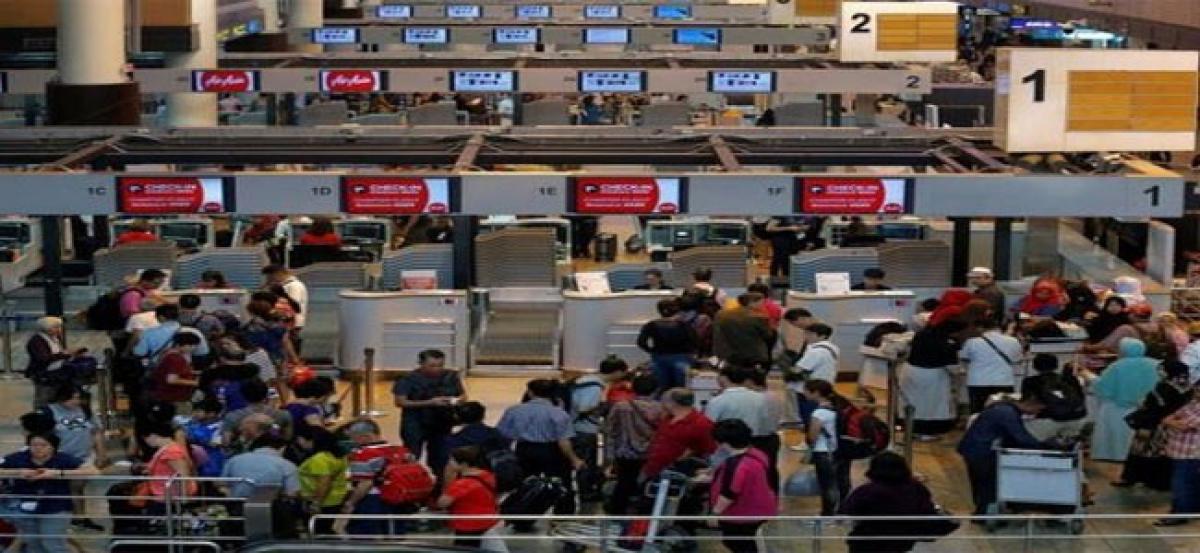Live
- Six scholars, including two women, win Infosys Prize 2024
- Gurukula zonal level sports meet concludes
- Vagdevi Jr College student selected for national basketball tourney
- Maoist area committee member arrested
- Collectorate staff protest attack on DC
- Villagers urge authorities to continue launch service even after construction of bridge
- MLA Padmavathi launches free lunch for readers
- Police high-handedness sparks outrage in Kodangal
- Khichi elected mayor of Delhi
- Sports enthusiasts encouraged to focus on achieving their goals
Just In

Amid growing air traffic, India would need to treble its airports capacity (terminal building capacity) at an estimated capital expenditure (CapEx) of Rs. 2.4 lakh crore in the next ten years, much higher than around Rs. 52,000 crore incurred over the last decade, credit-rating body ICRA opined.
New Delhi : Amid growing air traffic, India would need to treble its airports capacity (terminal building capacity) at an estimated capital expenditure (CapEx) of Rs. 2.4 lakh crore in the next ten years, much higher than around Rs. 52,000 crore incurred over the last decade, credit-rating body ICRA opined.
The airports infrastructure sector in India is increasingly getting constrained by the strong growth in traffic since FY2014. During the period, FY2014 to FY2017, the passenger traffic has grown by 57 percent, while the aircraft traffic has grown by 33 percent, compared to moderate capacity addition.
As of now, CapEx plans to the tune of Rs. 65,000 crore have been finalised by the Airports Authority of India (AAI) (Rs. 17,500 crore for next five years) and by private operators (around Rs. 22,000 crore for brown field expansion in Delhi, Mumbai, Hyderabad and Bangalore; and around Rs. 21,000 crore for Greenfield airports).
However, CapEx plans need to be ramped up significantly to build capacities for the anticipated level of passenger traffic, and apart from expediting execution, identifying funding sources would be important for the sector.
"In the past, apart from traditional debt and equity, other means that have been used to fund CapEx in the airport sector have included deposits from real estate and long term concessionaires, and debt backed by securitisation of a specific levy - airport development fee (ADF). Going forward, as the magnitude of CapEx increase significantly, the funding may see greater diversification with exploration of sources such as - a) Bonds backed by securitisation of User Development Fee (UDF) receivables; b) public listing of airports including structuring as investment trusts; c) greater funding from state governments; and (d) Private equity," said Harsh Jagnani, VP and Sector Head - Corporate Ratings, ICRA.
With moderate CapEx over the last few years and healthy cash flow generations, the leverage profile of the airport sector is comfortable, with total debt at around Rs. 19,000 crore. Out of this, 63 percent is funded by Indian banks/financial institutions and 28 percent is funded by foreign currency bonds. Also, AAI has mostly used internal accruals to fund CapEx in the past. But the situation is likely to change going forward with higher requirement of non-equity funding.
As per ICRA estimates, AAI's existing financial position gives it the capability to raise debt to the tune of around Rs. 20,000 crore. But given that the scale of investments required is much higher, its balance sheet may need to be recapitalised.
Further, the sector would require greater participation from the private players.
AAI can explore a model wherein it raises upfront funds by leasing some of the existing revenue generating airports to private concessionaires for a fixed concession period and deploying the funds so raised to meet its development plans.
However, greater involvement of private sector in airports would be possible mainly for airports with long track record of operations; greater certainty of traffic; and where the issue of managing the existing employee base can be addressed.
"The private players' participation in the sector had slowed down after the initial burst of 2004-2006 when Delhi, Mumbai, Bangalore and Hyderabad airports were privatised. Some of the major concerns which hampered private participation included regulatory uncertainties, restricted capacity of major infrastructure players given their liquidity constraints, funding constraints of the banking sector, and concerns regarding absorption of AAI's sizeable employee base in case of Brownfield airport privatization," said Jagnani.
"Nevertheless, many of these issues are progressively getting resolved, which along with the success of earlier privatised airports, is leading to the revival of private participation, as highlighted by recent concessions of airports in Navi Mumbai (Maharashtra) and Mopa (Goa)," he added.

© 2024 Hyderabad Media House Limited/The Hans India. All rights reserved. Powered by hocalwire.com







